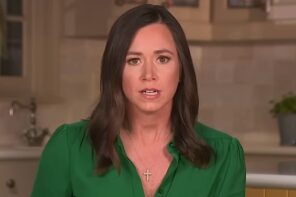Press coverage of Pope Benedict XVI’s visit to the United States, his first as Pope, acts like a mirror reflecting the media’s complicated role in reporting religious news as a whole. What could be more television-friendly than the sights and sounds of institutional Catholicism? Its colorful costumes, ancient rituals, and contemporary savvy at getting its message out are a producer’s dream. If the kind of coverage in 2005 that accompanied the death of Pope John Paul II and the election of his successor, Joseph Cardinal Ratzinger (now Benedict XVI) is any indication, we can expect a great deal of airtime and print space, very little if any critical analysis, and a lot of free press for the Roman Catholic Church.
I follow these issues as a cradle Catholic and a feminist theologian. My biases are clear: I love the community of sacrament and solidarity of which I am a part, and I take serious exception to the institution’s free ride in the press. The complexity of contemporary Catholicism—especially the fact that millions of Catholics want a participatory, democratic, horizontally integrated church with broadly based non-clerical leadership—is newsworthy.
Many such important issues, including the institution’s continued efforts to shape public policy on reproductive health, Catholic teachings against the death penalty, and Vatican financial dealings are obscured by the smoke and solemnity. We learn more from the press about the Pope’s red Prada shoes and designer sunglasses than about his criticism of the Iraq war. This time around in Washington DC and New York City, we hear about the “Pope-Soap-On-A-Rope” but not the people who work in Catholic schools for low wages. We see T-shirts for papal teddy bears, but no hint of the impact of the Vatican’s policy banning the use of condoms, even for those who are HIV-infected.
Whether it is a Sunday morning talk show, the front page of a newspaper, or the evening news, I continue to be amazed at how little the Vatican press office has to do to assure softball questions, few dissident voices, and reverent talk about the number of ciboria necessary to serve communion in baseball stadiums. And, we are all supposed to know what ciboria are (for the record, they are the goblet-shaped metal vessels that hold the hosts—that is, the wafers—used for communion). Catholic terminology is about the only thing used liberally in these exercises.
Television hosts like Tim Russert fairly swoon over their meetings with Popes. They bring none of their critical skills to bear on an institution and a nation-state. The Vatican City State has been a sovereign country since 1929; it has about 1000 inhabitants governed by the Pope, and, in his absence, by the College of Cardinals; all of whom are chosen by him. In the opinion of many people it is as secretive, punitive, and dismissive of human rights as some dictatorships. These are serious issues that warrant full discussion, not glossing over as if the correct liturgical colors and Gregorian chant were the essence of Catholicism. The media seem to be in the papal pocket.
The impact of this media approach is apparent on the many Catholic groups that represent lesbian and gay, divorced and remarried church members; groups like Catholics for Choice and Women’s Ordination Conference, voices seeking to be heard as Catholics, not as dissenters. We have learned over the years that there is simply no competing for media attention with the bulletproof Popemobile and the crowds of faithful. Protests and press conferences, women-led liturgies and other educational events take place before the man arrives with the hope that the press (looking for filler until the visit begins) might attend to them. By the time the papal masses and ceremonial meetings begin, the voices of dissent are long since forgotten by those who might offer more substantive coverage.
The Vatican learned its lesson in 1979. Mercy Sister Theresa Kane, then president of the Leadership Conference of Women Religious, welcomed Pope John Paul II to a gathering of nuns held in the Basilica of the National Shrine in Washington DC. Her gentle and generous welcome caused a stir because she dared to mention, albeit with deep respect, that the other half of the church (read: women) wants to be involved in all of its ministries. Her implicit reference to the ban on the ordination of women and women’s second-class citizenship in Catholicism was publicized around the world. The Pope did not comment directly at the time, but the fallout from the Vatican was harsh and unyielding toward Theresa Kane, the Sisters of Mercy, and Catholic women in general.
Virtually nothing has changed in thirty years. Catholic women are not ordained, hence not involved in most church decision-making. The hierarchical structure has not changed one whit; if anything, power is even more concentrated. I suspect that this reality will not get much media attention during the papal visit. I am quite sure that no one who has the honor of welcoming this Pope to his various venues will be granted such an unscripted opportunity to be candid. I am even more confident that few members of the press will notice.
My concerns could be seen as unique to a certain Catholic situation. But two underlying issues compel me to claim that there is more here than pique. First, the enormous size and reach of the Catholic Church makes it an important case of how religion is handled in the public arena. With a billion members around the world, and one of four people in the United States being claimed by the Catholic Church, it would seem that the press would be eager to explore this church critically and examine it as thoroughly as they do other large corporations, universities, health care providers, and other shapers of common life. Granted, few organizations can light a candle to the Vatican’s processions and the Pope’s moral claims. But for the press to pass over without critique the Vatican’s internal, exclusive structure (not to mention its convenient connections with governments like Libya and Iran at UN meetings in order to block consensus about population policies) is to abdicate an important role of the media. Rather than to please advertisers, I take it that the role of a free press, on religious issues as well as secular ones, is to raise issues of common concern, examine them, and help readers and viewers form their own opinions. If the issues are obscured, no such process can play out. A little practice with Catholicism would go a long way toward improving press coverage of smaller, less well known groups.
Second, if the American press cannot handle its responsibilities with regard to Catholicism (which is well known to many of them), how can we expect them to be helpful in reporting on Judaism, Islam, the Baha’i faith, Wicca, or any number of other groups that form the pluralistic religious mosaic in the United States today? No reporter or anchor could be expected to be an expert on the ins and outs of such groups. But as a matter of journalistic practice, I think it is reasonable to train reporters to look at more than meets the eye on religion, just as they are taught to investigate plane crashes and court cases.
The difficulty, of course, is that few people want to be thought of as engaging in religion-bashing. Who will bring up the inconvenient truth that the Pope’s US visit will cost more than a million dollars a day that might better be spent on health care for uninsured people? Who will mention that women will play only the most superficial roles in anything that he does? Who will notice that when the stadiums return to regular season action that the Church of Baseball will grant its adherents more participatory rights than the Catholic Church?
I suggest that we look in the mirror and admit that we as a culture need to learn how to talk about religion, both our own and other peoples’, in ways that do not offend or exclude. We need to figure out how to raise provocative questions with one another, assuming good intentions as well as a common willingness to think critically and constructively. We need to look at the big picture religiously, not simply at the made-for-television opportunities that are orchestrated to show the institutions to best advantage. Members of the press have a pivotal role to play in this educational task. Those of us who read, watch, and listen to them have an equally important part to play in expecting them to fulfill it.




